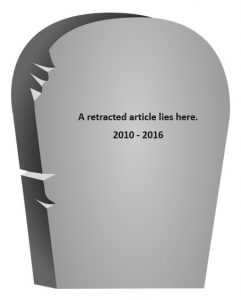Did you know that the word tombstone can also refer to a work that has been retracted after publication? The record for the work remains in the database as a placeholder and contains information as to the retraction along with a link to the retraction notice. Per Retraction Guidelines from the Committee on Publication Ethics (COPE), “retracted articles should not be removed from printed copies of the journal, nor from electronic archives but their retracted status should be indicated as clearly as possible.”
Retractions occur for a variety of reasons ranging from scientific misconduct such as data falsification, manipulation of data, or when the results and conclusions of the research are found to be invalid. A study of 2,000 biomedical and life-science articles found that 67% of retractions were attributable to misconduct, including fraud or suspected fraud, duplicate publication, and plagiarism.1
Some databases such as Elsevier Embase use Tombstone as a publication type (‘tombstone’:it) for retracted works. Per Embase guidance, tombstones are kept in the database but marked as Tombstone to show that the content might be invalid.
Other databases such as PubMed/MEDLINE use the publication type of Retracted Publication (Retracted Publication[PT]) to identify retracted works. Per guidance from the NIH National Library of Medicine, “Retraction of Publication” is assigned to the citation for the retraction notice, and the citation is linked to the citation for the retracted article. “Retracted Publication” is assigned to the retracted article.
The Retraction Watch offers a database that allows for searching of retracted works and includes the reason/s for the retraction and any notices.
1 Fang FC, Steen RG, Casadevall A. Misconduct accounts for the majority of retracted scientific publications. Proc Natl Acad Sci U S A. 2012 Oct 16;109(42):17028-33). https://doi.org/10.1073/pnas.1212247109.
Readings
Bakker C, Riegelman A. Retracted publications in Mental Health literature: Discovery across bibliographic platforms. Journal of Librarianship and Scholarly Communication. 2018;6(1):eP2199. http://doi.org/10.7710/2162-3309.2199.
Brainard J, You J. What a massive database of retracted papers reveals about science publishing’s ‘death penalty’. Science. October 25, 2018. http://doi.org/10.1126/science.aav8384.
Grieneisen ML, Zhang M. A comprehensive survey of retracted articles from the scholarly literature. PLoS One. 2012;7(10):e44118. http://doi.org/10.1371/journal.pone.0044118.

